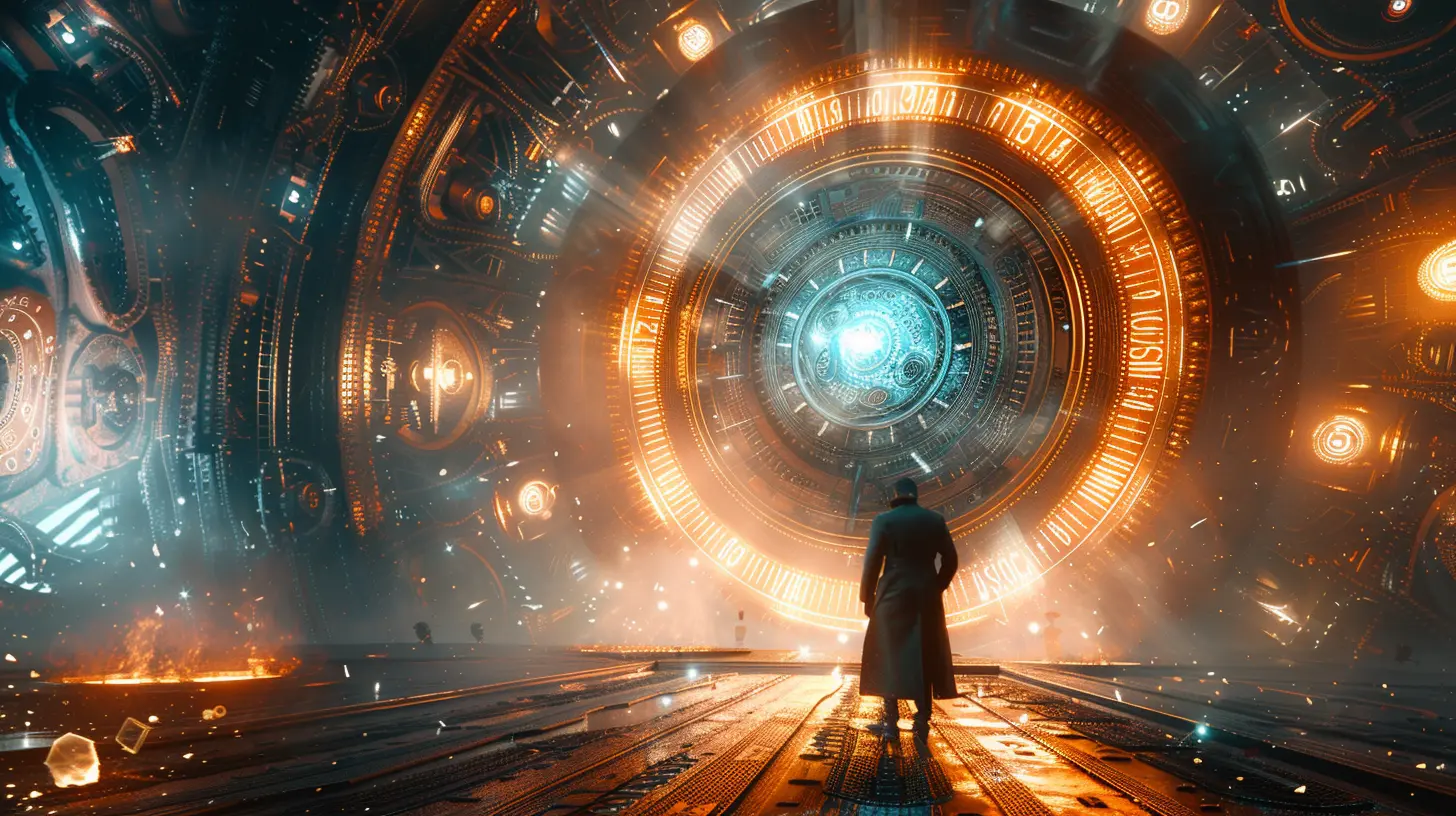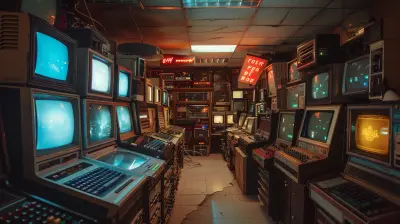Time Travel in Games and Its Narrative Potential
6 November 2025
Let’s be real—time travel is one of those juicy sci-fi concepts that never gets old. I mean, who doesn’t love playing with the idea of hopping backwards to fix a royal screw-up, or leaping ahead to peek into a glittery (or utterly dystopian) future? And when you throw time travel into video games? Whew, things get wild.
Forget save points and rewinds. We're diving into games where the fabric of time itself is part of the story, gameplay, and your entire emotional experience. Fasten your seatbelt. We’re about to take a cheeky little trip through the timelines of gaming and dissect how time travel’s been flexing its narrative muscles.
The Time-Travel Trope: Old, But Still Gold
Time travel isn't exactly fresh outta the idea oven. It’s been around movies, books, and comics for ages. But games? They take it a step further. You're not just watching someone fix the past—you’re doing it. You're not screaming at a character not to push the red button. You're the one with your finger hovering above it.In gaming, time travel isn’t just plot syrup—it’s the whole dang pancake. When done right, it reshapes gameplay mechanics, world-building, and how you connect emotionally with the narrative. Suddenly, every decision you make feels as heavy as a black hole. Why? Because you’re not just messing with the present—you’re dancing with the past and tickling the future.
The Butterfly Effect: Small Choices, Big Ripples
Say hello to your new best frenemies: cause and effect. One of the most exciting parts of time travel in games is how your tiny actions can snowball into major changes. Think of it like stepping on a butterfly in 1995 and waking up in 2095 as the emperor of Mars. Okay, that’s extreme—kinda—but in games, stuff like that happens all the time.Example? Let’s Talk Life is Strange
Ah yes, Max Caulfield, our camera-toting, time-bending queen. In Life is Strange, the whole deal is based on rewinding time and tweaking decisions. At first, it feels like an emotional cheat code—you get to undo your social slip-ups! But then the weight creeps in. Suddenly, your rewinds aren't just cute do-overs. They’re making waves—sometimes, ugly ones.The game shows how time travel doesn’t just change outcomes—it changes you. You're not just revisiting moments. You're reliving trauma, reprocessing grief, and dealing with the consequences of playing god. It’s storytelling with a sting.
Loop de Loop: Time Loops That Mess With Your Head
Ever feel like you're doing the same thing over and over? Welcome to time-loop gameplay—the Groundhog Day of video games. Except instead of a groundhog, you've got puzzles, emotional growth, and the existential dread of being stuck in a loop forever. Yay?Let’s Get Loopy with The Legend of Zelda: Majora’s Mask
Three days. Clock’s ticking. Welcome to Termina, baby.In Majora’s Mask, you’re caught in a 72-hour loop before the moon drops like a wrecking ball and smashes everything. The genius? You reset the loop but keep your knowledge and tools. It’s like cramming for a test, but instead of acing Algebra, you're saving a world from lunar annihilation.
The loop is more than a mechanic—it’s the lens through which the story’s told. Every NPC has a schedule. Tragedies unfold unless you intervene. It’s intimate, personal, and weirdly poetic. You’re not just a hero—you’re a time-surfing therapist fixing broken lives.
Parallel Universes and Timeline Tampering
Time travel in games often means tampering with timelines and entering alternate versions of reality. This isn’t just "what if I made a different choice?" It’s “what if reality glitched, and now my allies are enemies, my dog’s a demon, and I never existed?"Cue Chrono Trigger, The Granddaddy of It All
Let’s respect our elders—Chrono Trigger walked so modern time-travel games could sprint into paradoxes.Its genius is how it plants you in multiple time periods: prehistoric, medieval, futuristic—you name it. Your actions in the past reshape the present and future. It’s like strategic gardening with the fate of the universe.
You don’t just smack enemies around. You plant seeds (literally and figuratively), affect tech progress, and even help lead characters evolve—sometimes across centuries. It’s not just storytelling; it’s narrative acrobatics.
Time as a Weapon: Manipulating the Flow
Time travel doesn’t always mean jumping between centuries. Sometimes it’s all about controlling time itself—slow it down, pause it, or rewind it mid-combat. Because honestly, why dodge a bullet when you can just freeze it?Cue Prince of Persia: The Sands of Time
This one was a revelation. You got the power to rewind time in the middle of combat. Screwed up that wall run? No problem. Tweeze time backward and try again.The rewind mechanic wasn’t just clever—it was intuitive AF. It made the Prince feel powerful but vulnerable. You weren’t untouchable—just temporarily less bad at acrobatics. It brought a sense of rhythm to action and made the narrative about redemption, second chances, and—not to get too deep—our obsession with fixing the past.
The Trippy Mind-Benders: Games That Go Full Sci-Fi
Then you’ve got games that throw logic out the window, burn the timeline rulebook, and just say “screw it, let’s get weird.”Outer Wilds: A Cosmic Time Loop and Existential Crisis
This indie darling doesn’t just slap a time mechanic into its design—it builds its entire universe around a 22-minute loop before the sun goes kaboom.You're an alien astronaut unraveling the bigger mystery of space, time, and mortality. The world resets, yes, but your knowledge stays. That’s the masterstroke. The game rewards curiosity and discovery, not levels or loot. It’s like Majora’s Mask met Interstellar and had an artsy genius baby.
And the feels? Oof. It hits hard. The dread of death. The beauty of discovery. The heartbreak of impermanence. Not bad for a game where you can accidentally fly into the sun.
The Emotional Currency of Time Travel
Here’s where time travel gets juicy: emotion.Games that mess with time don’t just challenge your brain—they break your heart in the best way. Why? Because time travel is tied to regret, longing, and second chances. It’s the desire to change things, to fix what we couldn’t get right the first time.
You’re not just zipping through eras—you’re confronting truth. Childhood guilt. Lost love. Mistakes you wish you hadn’t made. Time travel in games is a metaphorical goldmine. It makes us ask:
- What would we change if given the chance?
- Would that change make things better—or worse?
- Can we really run from time, or are we just spinning our wheels?
Heavy stuff for a medium where jumping on mushrooms used to be the peak of narrative depth, right?
When Time Travel Goes Sideways
Okay, but let’s not pretend time travel is flawless in games. It can get messy—fast.Badly executed time travel plots spiral into plot holes, weird logic gaps, and mind-numbing exposition. You get stuck in “but wait, if this happened, then how did THAT happen?” territory. And suddenly, the narrative that was supposed to feel deep just feels like a hot mess with a sci-fi filter slapped on.
Games that try too hard to sound smart end up breaking their own rules. That’s the risk. Time travel isn’t just a feature—it’s a commitment. If your world-building isn’t tight, players will chew it up and spit it out.
Indie Gems and Under-the-Radar Time Twisters
You don’t need AAA budgets to pull off great time narratives. Some of the cleanest, freshest takes come from indie developers who use constraints as creative springboards.Examples Worth a Peek:
- Braid – A painterly platformer with time manipulation that turns into a gut-punch narrative about obsession.- The Forgotten City – A Roman-era mystery wrapped in a time loop where breaking one rule dooms everyone. Think Among Us meets 12 Monkeys.
- Twelve Minutes – A top-down thriller where you're trapped in a time loop inside a tiny apartment. It’s intimate, disturbing, and will make you question everything.
These games prove you don’t need guns or galaxies to make time travel hit hard. You just need smart design and a good story hook.
Why We Keep Coming Back
So why is time travel such a big deal in games, over and over again?Because it taps into something primal. The desire to go back. To undo. To relive. To understand. It’s escapism, sure—but it’s also healing. It’s wish-fulfillment with consequences. And man, does that make for good storytelling.
Games let us tinker with time in a way books and movies can’t. They put you in the driver’s seat. Want to break the timeline? Go ahead. Want to save the girl (or not)? Your call.
That interactivity makes time travel not just a narrative trick—but a deep emotional journey. And when done right, it doesn’t just entertain. It resonates.
Final Thoughts: Time Travel Ain’t Going Anywhere
Let’s wrap this up, shall we?Time travel in games is more than flashy mechanics and sci-fi tropes. It’s emotional truth wrapped in narrative brilliance. It challenges us, breaks us, and gives us hope. It lets us wrestle with the biggest "what ifs" and come out the other side feeling—well, something.
So next time someone tells you games aren’t art, fire up your time travel masterpiece of choice and let them eat paradoxes.
all images in this post were generated using AI tools
Category:
Game StorylinesAuthor:

Tayla Warner
Discussion
rate this article
2 comments
Annette Wheeler
Time travel in games offers a unique narrative lens, allowing players to explore consequences of choices and alternate timelines. This mechanic not only enhances storytelling but also engages players in moral dilemmas, enriching their emotional investment and prompting reflection on the nature of fate and agency.
November 21, 2025 at 4:15 PM

Tayla Warner
Thank you for your insightful comment! I completely agree that time travel in games deepens storytelling and encourages players to reflect on their choices and the impact of their actions.
Zyana Conrad
Time travel in games is such a fascinating concept! It opens endless narrative possibilities—imagine the complexities of choices and consequences. I can’t wait to see more!
November 17, 2025 at 5:05 PM

Tayla Warner
Thank you! I'm glad you find the concept of time travel in games intriguing. It truly offers unique storytelling opportunities and complex character dynamics that can enhance gameplay.


